Most Lustrous: the ceramics of Julia Carter Preston
Posted on: 13 January 2023 by Amanda Draper, Curator of Art and Exhibitions in 2023
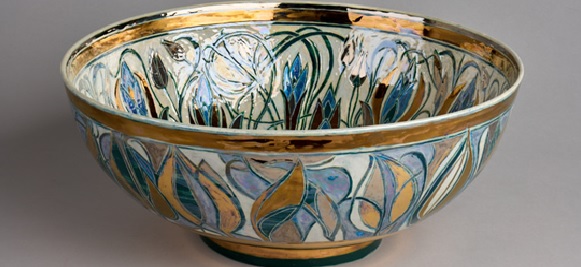
At the VG&M we have two objects on display that everybody admires. One is a large bowl and the other a jar topped with a golden fish. They are by the acclaimed Liverpool ceramics artist, Julia Carter Preston, and are gleaming and gorgeous. Let’s find out more about the artist and the historic background to her style and technique.
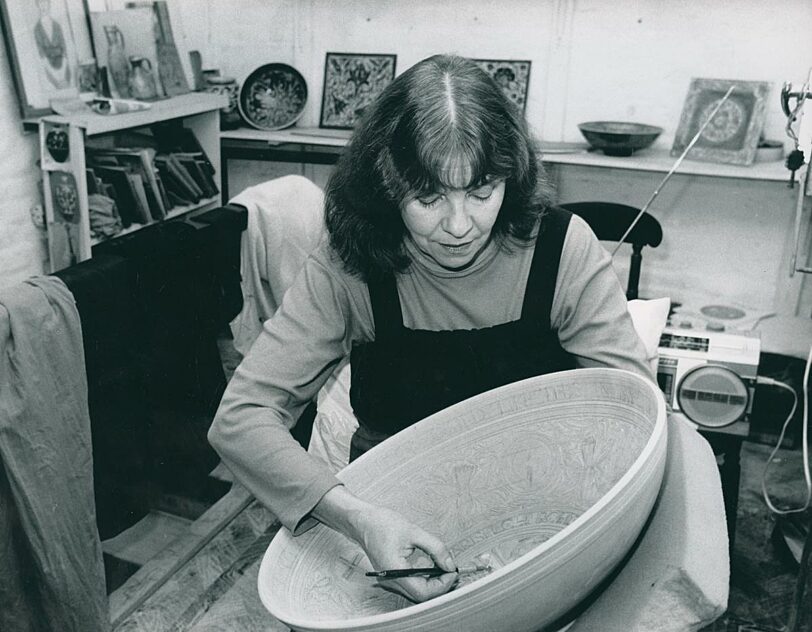
Julia Carter Preston at work in her Bluecoat studio c.1985. © The Bluecoat
Julia Carter Preston
Julia was born in Liverpool in 1926 and studied at Liverpool School of Art during the 1940s, specialising in ceramics. After gaining her National Diploma in art in 1951, she taught ceramics in various colleges in the region, including Liverpool School of Art, where she became Head of Ceramics. John Lennon was among her many students. Julia also developed her career as a practising artist, working from a studio in the Bluecoat Chambers. By the mid-1970s she had largely left teaching to flourish as a professional full-time potter. Julia’s home was on Liverpool’s Canning Street which she shared with her husband, Dr Michael Pugh Thomas (1932 – 2011), a graduate of the University of Liverpool in marine biology and an eminent environmental scientist.
_cc_Gary,Blakeley.jpg)
WW1 Memorial plaque (or 'death penny') designed by Edward Carter Preston. Photo by Gary Blakeley, published under Creative Commons licence.
The Carter Preston Family
Julia came from a renowned artistic Liverpool family. Her father, Edward Carter Preston (1885 – 1965), was a sculptor specialising in relief works including medals. He is, perhaps, best known for that saddest of all mementoes, the bronze memorial plaques given to the families of British service personnel who died during World War One, often known as the ‘death penny’. Another prestigious and more local commission was for a series of sculptures for Liverpool’s Anglican Cathedral. He incorporated images of his wife, Marie, and daughters (including Julia) into his work around the building. Another Liverpool artist, the sculptor Herbert Tyson Smith, was Edward’s brother-in-law and Julia’s uncle. Julia’s sister, Irene, was a noted silversmith and jeweller.
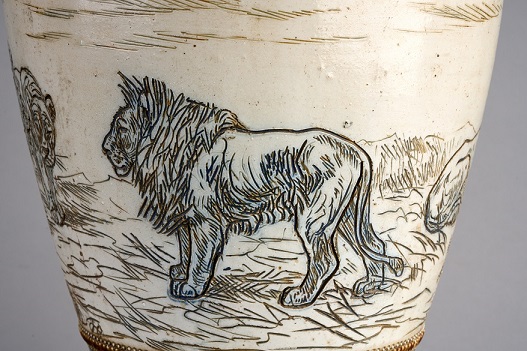
Sgraffito incised image of a lion on a vase decorated by Hannah Barlow, 1885 (detail), VG&M Collection.
Sgraffito decoration
Julia Carter Preston’s ceramics are known and prized for two decorative aspects: her use of sgraffito designs complemented with metallic lustre glazes. Sgraffito is an ancient decorative technique, and the name derives from the Italian ‘graffiare’ – to scratch. In Europe it was popularised in Renaissance Italy, but the technique is found even earlier in the arts of the Islamic world, China, Japan and Africa. To create the effect, an unfired clay form dried to be ‘leather hard’ is covered in a slip or glaze of contrasting colour. This top layer is then incised with a sharp tool to reveal the contrasting colour beneath. In most cases, ceramicists leave their sgraffito wares with just the two colours, giving a graphic, linear effect (see above), but Julia chose to infill hers with lustre glazes.
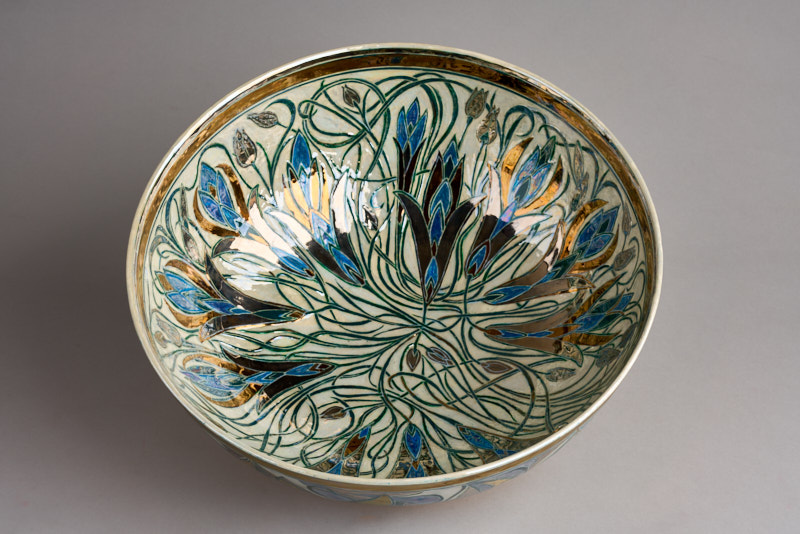
Interior of sgraffito and lustre glaze bowl by Julia Carter Preston, 2001. VG&M Collection. By kind permission of the Liverpool Hope Carter Preston Foundation.
Lustre glazes
Julia’s choice of metallic lustre glazes very much echoed the historic origins of the designs she used, which were derived from Islamic traditional floral motifs and occasionally animals. In particular, her work referenced pottery made in the town of Iznik in what is now Turkey (then Western Anatolia) from the late 1400s. It used flowing, organic shapes in bold blues, reds and greens against a white body. Some of the great names in British design, such as William Morris and William de Morgan, were also influenced by Iznik pottery. For Julia, the flow of pattern was what interested her, saying “I like things that float and bend and weave around”.
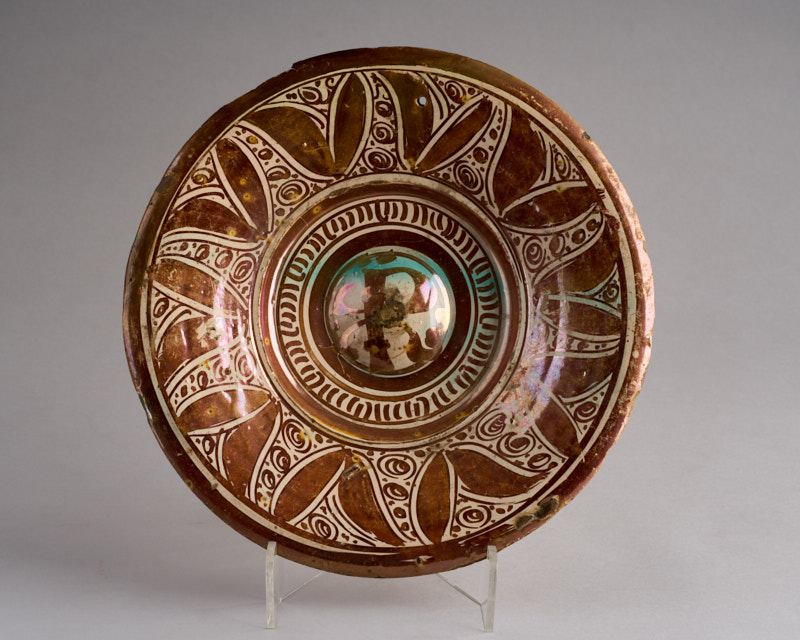
Hispano-Moresque lustreware charger, c.1600. VG&M Collection
What really set Julia’s work apart was her use of iridescent metallic lustre glazes. Again, the use of such glazes originates from the Islamic world, and can be traced back to Iraq during the 700s. The use of lustre glazes by Western potters began in Spain during the 1400s while it was under Islamic rule, and production centred around the town of Manises near Valencia. It is a form of ceramics known as Hispano-Moresque ware and we are lucky to have an example in the VG&M collection (see above). Julia was outstandingly talented in her use of lustre glazes which are tricky to use with rather unpredictable outcomes. For a ‘gold’ effect, silver oxides are used, while gold oxide itself give pink and purple shades depending on the metallic concentration. Platinum salts give a silver effect and bismuth salts give a mother-of-pearl appearance. Julia often used a blue glaze, probably created using cobalt.

Lidded jar with sgraffito figuring and lustre glazes by Julia Carter Preston, 2001. VG&M Collection. By kind permission of the Liverpool Hope Carter Preston Foundation.
Artistic legacy
Julia and her husband Michael were regular faces on the Liverpool art scene attending exhibition openings and other cultural events. She cut a striking figure with her red hair and lipstick, wearing bright and original clothing. During her life Julia did not achieve recognition by the London art establishment, but local collectors were keen to buy from her exhibitions at commercial galleries. However, as her reputation grew, she was rewarded with important commissions, often for commemorative pieces to celebrate special events. A piece was gifted to Princess Margaret during a Royal visit to the Bluecoat. A major retrospective of her work was held at the Walker Art Gallery in 1999 and she was made a Fellow of Liverpool John Moores University in 2005. Julia’s work is held in several public art collections around the country, including the VG&M. The couple did not have children and on their deaths (Julia in 2012 and Michael in the preceding year), the Liverpool Hope Carter Preston Foundation was established. It is a charitable trust administering Julia’s artistic estate and archive, plus that of her father, Edward, and her sister Irene.

Golden sea bass atop a lidded vase by Julia Carter Preston. By kind permission of the Liverpool Hope Carter Preston Foundation.
On display
In 2001 the University of Liverpool commissioned a large bowl and jar with a golden sea bass on its lid from Julia Carter Preston. Both are on show in our Gallery 1 as part of display about the influence of Islamic design on Western ceramics.
References:
Biographies of Julia Carter Preston
https://www.theguardian.com/artanddesign/2012/jan/22/julia-carter-preston
https://www.liverpoolecho.co.uk/news/liverpool-news/julia-carter-preston-part-liverpool-3351900
https://www.telegraph.co.uk/news/obituaries/9023658/Julia-Carter-Preston.html
Information on Iznik and Manises ceramics
https://www.christies.com/features/Iznik-Pottery-Collecting-Guide-7183-1.aspx
https://www.ceramopolis.com/?page_id=473
https://manisescityofceramics.es/en/lustreware/
https://www.demorgan.org.uk/lustreware-a-short-history/
Keywords: Julia Carter Preston, Edward Carter Preston, Michael Pugh Thomas, Bluecoat Studios, Lustreware, Sgraffito, Liverpool School of Art, Ceramics.